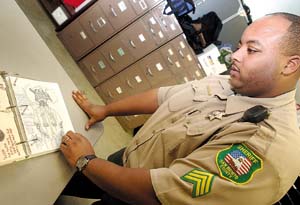
Gang violence isn’t exclusive to city streets. It persists even
within the confines of the San Benito County Jail, where
corrections officers are forced to fight a daily battle to keep
inmates, and themselves, safe.
Hollister – Gang violence isn’t exclusive to city streets. It persists even within the confines of the San Benito County Jail, where corrections officers are forced to fight a daily battle to keep inmates, and themselves, safe.
“It’s an all out war,” said Jail Commander Edward Escamilla. “What’s out on the streets continues in here, they just don’t have guns.”
Escamilla, who is charged with running the day-to-day operations of the county jail, has only two weapons to combat gang violence in jail – information and segregation.
Members of rival criminal street gangs are confined to separate cell blocks and kept apart at all times, Escamilla said.
“They don’t intermix,” he said. “It would be like throwing a cat in with a bunch of dogs – (rival gangs) have orders to attack each other.”
Although gang members are kept separate, some contact can’t be avoided when transporting the inmates to and from court or moving them from one cell to another.
“Inmates are now escorted to and from their cells,” Escamilla said. “But we’ve had inmates assault one another right in front of our officers – the presence of an officer doesn’t stop them.”
Several months ago, two gang members attacked a rival member with a broken broomstick and toilet brush; breaking his ankle, turning his face bloody and covering his body with bruises, Escamilla said. But that type of violence is rare – it happens, but only in spurts, he said.
Those orders are filtered down through a strict, and often complex, hierarchy of gang members, said Sgt. Anthony Barnes.
“All the orders go through a certain person,” he said. “It’s almost like a para-military structure.”
Order can include everything from when to wake up in the morning, how many hours to spend working out and even who to attack, said Corrections Officer Mike Kirschmann.
Although many of the self-imposed rules are designed to keep gang members in line and working as a unit during their stay in jail, others have a more practical purpose.
“(Gang members) also have to have someone nearby when they talk to us,” Kirschmann said. “In order to make sure they’re not snitching.”
Although the rules vary by gang, a leader is always present to make sure they are followed.
“When one leaves, he will appoint someone to take his place,” Barnes said. “Someone is always in charge.”
And gang members who don’t follow directions are often beaten into submission by their peers, Escamilla said.
“There is always somebody calling the shots,” he said. “And you get disciplined if you fail to obey a direct order.”
Gang leaders use small strips of paper filled with tiny handwritten notes to communicate their orders, which are referred to as “house-hold policy,” according to a former Norteno gang member who was in jail for failing to meet with his probation officer.
The inmate, who spoke only on the condition of anonymity because he feared retaliation to his family, said the rules are extensive and serve many purposes.
“It’s about professional conduct, respect and not drawing attention,” he said, in an interview in the presence of a corrections officer. “The rules are just the same as principles and ethics that normal people have on the outside.”
The inmate said active Norteno gang members don’t like him because he disassociated himself with the gang – a decision he made when fellow gang members failed to write him letters or send money during a prior jail stint for drug charges several years ago.
“I just walked away and they hate that,” he said. “And I have lots of information about them.”
In order to keep things under control, correction officers use a computer system to track each inmate. The system includes the inmate’s height, weight, tattoos and gang affiliation, Escamilla said.
“The key strategy is classification and segregation,” he said. “But there is only so much closet space to segregate these people.”
Cell Block D, which is reserved for Norteno gang members, was nearly at capacity Wednesday and Escamilla worries that if gang violence continues to escalate on the streets, he will need a bigger jail.
Brett Rowland covers public safety for the Free Lance. He can be reached at 831-637-5566 ext. 330 or br******@***********ws.com.








